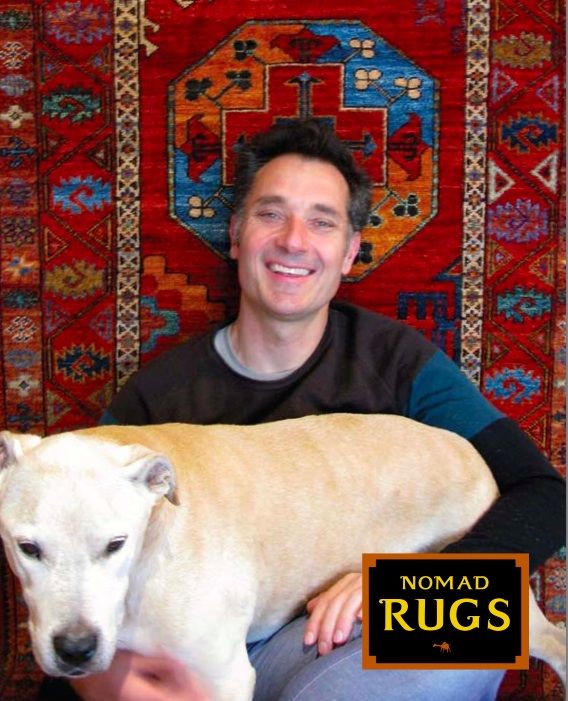General advice for buying a rug
You don’t need to know a lot about oriental rugs to buy a good rug. Most important, I would urge you to buy what you love. Buying an oriental rug is buying art that will fill your home with beauty you’ll appreciate every day. Find a rug that speaks to you and you will cherish your purchase forever.
There is no better bargain than buying a rug you love from an honest dealer. There are many phony and dishonest sales (“Going Out of Business Sale” “Seized Customs Auction”, etc.) where the original price of a rug is falsely inflated to give customers the impression that the sales price is a huge discount. In reality, these are no bargains. And often, the rugs offered in these sales are second-rate goods that a reputable retailer wouldn’t dare sell. A good dealer will select only fine pieces for their inventory.
A good dealer will also always allow you to try a rug out before making your selection. Before you buy, try a rug out at home. A rug you see in the showroom will always look different when you bring it home. Trying a rug out allows you time to inspect the subtleties in design and color that make a great rug. As a policy, we encourage customers to take rugs home for several days so they can live with them and see how they work. This is all part of your rug education.
Often, your first choice will not be the ideal rug for you home. Finding the right rug may require you to try a couple of different rugs out. Don’t feel rushed to buy a rug. And be sure to find a dealer that will allow you to try them out.
If you are about to buy your first rug, spend some time educating yourself and training your eye. With time, subtle differences in design and color will become more apparent. The rugs to which you were initially attracted may appear less interesting as you get a better sense of good color, good wool and balanced design.
These days, there is a lot of good information on the Internet. Click around on the links on this site and explore. There are also some good books that can provide background knowledge. Yet, nothing beats seeing and touching actual rugs.
Come by our shop or visit the shops in your area. Bring your measurements, swatches, room photos and questions. Touch and feel as many rugs as possible; some rugs are thicker, some rugs are thinner; some have soft wool, some have scratchy wool. Look at the back of the rugs to learn about the tightness of the weave and the uniformity of the knots. Ask lots of questions. We encourage looking and touching and learning how our rugs are made.
Oriental rugs are different than all other rugs in that the wool pile is hand-tied to their foundation. The average rug has around 100 knots per square inch. This helps explain their longevity. A good rug will last 50 to 100 years. Many of the antique rugs in our collection are well over a century old. This also accounts for their expense. Each knot is tied in place by hand. A large rug represents well over a year of work.
Not all oriental rugs are created equal. Materials are paramount. Rugs in our shop have a distinct look and feel because they are made with handspun wool and natural dyes. Handspun wool is stronger and more textured than machine spun wool. This wool has a noticeable glow. It feels fleecy, perhaps a little oily and soft. It absorbs dye well and it takes heavy use. And natural dyes have a pleasing organic quality. In my opinion, color is more important than design.
Natural dyes and hand-spun wool add to the expense of producing rugs but they also add to their value. And, it is safe to say that no rug buyer will regret the beauty that superior materials guarantee.
There is a wide range of prices for oriental rugs. Our new naturally dyed rugs sized 8’x10’—a size that usually fits most living rooms—are priced between $2,500 and $9,500. Factors that influence the price include the quality of materials, the knot density and the country of origin. Rugs made with synthetic dyes and machine spun wool cost less than those made with natural dyes and handspun wool.
Furthermore, the cost of the rug rises when there is a greater amount of knots per inch (KPI: a standard measure of knot density). This measure can be compared to the resolution of a digital camera. More knots per inch allows for a more detailed design or higher resolution.
And finally, the cost of rug production is more expensive in some countries than in others. Producing rugs in Turkey and Iran, for example, is more expensive than in Pakistan or Afghanistan. We are happy to work with your budget to find the rug that is right for you. All our prices are listed on our web site.
One final word of caution: Watch out for the rug bug! Oriental rugs can be addictive. I made my first purchase over twenty years ago. I got bit. And now, I couldn’t imagine life without oriental rugs.
– Christopher Wahlgren, owner of Nomad Rugs

 © 2025 Nomad Rugs. All Rights Reserved.
© 2025 Nomad Rugs. All Rights Reserved.